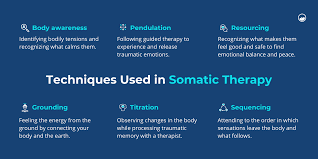What is Somatic Therapy and How Does it Work?
Unlocking the Power of Somatic Therapy: A Guide to Holistic Healing
In the ever-evolving field of holistic healing and mind-body wellness, Somatic Therapy has emerged as a powerful tool to address physical pain, psychological distress, and the profound impacts of trauma.
It functions under a principle that believes the body and the mind are not separate – what happens to the body affects the mind, and vice versa.
Somatic Therapy is a form of body-centered therapy that looks at the connection of mind and body and uses both psychotherapy and physical therapies for holistic healing.
It encompasses a vast umbrella of techniques, including Somatic Experiencing Therapy, Body-Oriented Therapy, Movement Therapy, and more, each focusing on the principle of relieving the trapped tension and stress in the body through a range of physical techniques.
In our contemporary world, where stress, anxiety, and burnout have become commonplace, Somatic Therapy’s importance and relevance cannot be overstated.
As we grapple with the impacts of a fast-paced, ever-connected lifestyle, traditional therapy methods often fall short.
The body’s physical manifestation of psychological distress often creates a cycle of physical pain and psychological anguish, which can not be adequately addressed without considering the body-mind connectivity. This is where Somatic Therapy makes its mark.
Its focus on recognizing and releasing physical tension that corresponds to mental stress can be transformative for individuals battling chronic stress, trauma, anxiety, and depression.
Moreover, it presents a holistic healing technique that embraces the individual’s entirety, providing a hands-on approach to wellness far removed from the one-size-fits-all approach of traditional medicine.
In this comprehensive guide, we will delve deeper into the world of Somatic Therapy, exploring its many facets, techniques, and benefits.
We will provide an in-depth look at the proven strategies within this domain and how they can contribute to overall health and well-being.
So if you’re ready to embark on a journey of self-discovery and holistic healing, read on to understand how Somatic Therapy could unlock doors to a healthier, happier you.
Defining Somatic Therapy

The roots and origins of Somatic Therapy
Somatic Therapy, in its essence, is deeply rooted in the understanding and exploration of the body-mind connection.
The term ‘somatic’, derived from the Ancient Greek word ‘somatikos’, refers to the body, distinguishing it from ‘psyche’, the mind.
This therapy began its journey on the fringes of psychotherapy and made its way into mainstream counselling and therapeutic practice.
Dr. Wilhelm Reich, a disciple of Sigmund Freud, made significant contributions to somatic psychology, emphasizing that muscular tension was a physical manifestation of suppressed emotions.
He suggested that releasing this tension could support emotional release as well, allowing people to experience holistic healing.
Over the years, further advancements were made by practitioners such as Alexander Lowen, Ida Rolf, and Peter Levine, culminating in diverse somatic therapy methods like Body-Oriented Therapy, Somatic Experiencing Therapy, and Trauma Release Exercises.
Exploring the meaning of ‘Somatic’
In the context of therapy, ‘somatic’ refers to the lived experience within the body beyond our conscious control, including the perception of movement, temperature, and pain, controlled by the ‘somatosensory system’.
This system allows us to sense the world around us and respond accordingly – a critical survival skill. The relationship between the mind, body, and ‘somatic’ is a complex interplay.
Our body responds to the signals we receive from our environment, while our mind interprets these signals and elicits appropriate reactions based on previous experiences and inherent patterns.
Detailed Description of Somatic Therapy
At its core, Somatic Therapy integrates the physical, emotional, and spiritual aspects of a person.
It employs methods like conscious breathing, movement therapy, emotional bodywork, and body-centered psychotherapy to help individuals release pent-up tension that is negatively affecting their physical and emotional wellbeing.
Somatic therapy addresses a wide range of conditions and problems. It is commonly used for post-traumatic stress disorder (PTSD), stress-related disorders, anxiety, depression, and trauma.
Moreover, it can also aid in alleviating physical ailments like chronic pain, migraines, and arthritis by addressing the emotional and psychological aspects contributing to these conditions.
There are several aspects setting Somatic Therapy apart. For one, it recognizes the profound connection between the mind and body and leverages it for healing. Secondly, it does not just address the symptoms but also explores their deeper cause, providing a more comprehensive solution.
Lastly, it places its trust in our body’s inherent wisdom and ability to heal itself, once provided with the right conditions.
Engaging with Somatic Therapy breaks the chain of chronic stress and the havoc it wreaks on our body and brain. It realigns our energy, clears our mind, and provides a unique pathway to overall wellness.
As we move forward, we will delve deeper into the techniques used in Somatic Therapy, their applications, and their benefits, empowering you to make informed decisions on your journey to holistic health and well-being.
How Does Somatic Therapy Work
The science behind Somatic Therapy
The biological process central to Somatic Therapy is the stress response. When we experience a threat—physical or psychological—our body enters survival mode, producing stress hormones like adrenaline and cortisol. This response prepares us for ‘fight, flight, or freeze’.
Unfortunately, in our current high-stress environment, this system often remains constantly activated, leading to both physical and mental health complications.
However, understanding the connection between mental and physical aspects forms the basis of Somatic Therapy. Our somatic or body responses to stress reflect our mental state.
Likewise, changing the body responses or releasing stored tensions can impact our psychological state.
Thus, Somatic Therapy effectively facilitates healing by working with the body to alter our stress response patterns and induce a state of relaxation and calm.
Somatic Therapy plays a pivotal role in healing trauma. Often, traumatic experiences that our conscious mind can’t process get stored in our body, manifesting as chronic tension or pain.
Techniques such as Somatic Experiencing Therapy or Trauma Release Exercises guide individuals to safely release this tension, which, in turn, aids in processing and healing from the trauma.
The process of a typical Somatic Therapy session

Somatic Therapy, including the techniques like Sensorimotor Psychotherapy, Movement Therapy, and Emotional Bodywork, typically begins with creating a safe therapeutic space.
In a session, you can expect the therapist to guide you to focus on your physical sensations and ‘listen’ to your body.
The role of a Somatic Therapist is akin to a guide who facilitates your journey of self-discovery, aiming to bring about awareness of your body’s ‘story’ and its sensations, and assisting you to release stored distress.
Methods may include coaching in breathing exercises, movement exercises, or bodywork administered by the therapist, depending on the approach used.
The duration and number of sessions required in Somatic Therapy can vary widely based on the individual’s needs and the issues being addressed.
It is not a ‘quick-fix’ but a process of exploration and healing, allowing the body to release tension at its own pace.
The efficacy and effectiveness of Somatic Therapy
Empirical research supporting the effectiveness of Somatic Therapy, particularly in treating trauma and stress disorders, is increasingly growing.
Several studies point to its positive impacts, especially for those who have found limited success with traditional talk therapy.
Somatic Experiencing Therapy, in particular, has been shown to significantly reduce symptoms of PTSD.
The efficacy of Somatic Therapy lies in its holistic approach, acknowledging the profound connection between our physical and psychological selves. However, like any therapeutic approach, Somatic Therapy has limitations.
It requires active participation, a level of comfort with physical touch in some methods, and can sometimes lead to intense emotional release.
It’s essential to work with a trained and experienced therapist and communicate openly about any concerns or boundaries you might have.
As we explore further, we’ll take a look at the various techniques encompassed within Somatic Therapy—understanding their application, their benefits, and how they collectively form a comprehensive tool in the journey towards holistic health and well-being.
Benefits of Somatic Therapy
:max_bytes(150000):strip_icc():format(webp)/GettyImages-1369185059-dd85e2f909504b3baf547fc409b06e1e.jpg)
Physical benefits of Somatic Therapy
The primary aim of Somatic Therapy, be it Somatic Experiencing Therapy, Neuromuscular Therapy or any other form, is to facilitate relief from physical discomfort caused by stored tension or trauma.
The essential principle is that the body often ‘holds onto’ unprocessed emotional turmoil, resulting in chronic muscle tension, digestive issues, migraines, or other physical ailments.
By releasing this tension, Somatic Therapy brings about a sense of physical relaxation and ease. Somatic Therapy can relieve a range of conditions or diseases, thanks to its focus on the body-mind connection.
Chronic pain, fibromyalgia, respiratory issues, cardiovascular problems, gastrointestinal disorders – all these can potentially find relief through this therapeutic practice.
The long-term physical outcomes from the therapy will depend on the individual’s unique situation.
Still, they may include diminished physical pain, enhanced sleep quality, improved digestion and immunity, increased energy levels, and a general sense of well-being.
Mental and emotional benefits of the therapy
For many, the mental and emotional benefits of Somatic Therapy are even more profound than the physical ones.
This is where techniques such as Body-centered Psychotherapy, Emotional Bodywork and Sensory Awareness come into play, leading to an improved mental health and well-being. Somatic Therapy plays an essential role in managing stress, anxiety and depression.
By guiding individuals to tune into their bodily sensations, it allows them to address emotions they may not even have been consciously aware of.
Over time, this brings about a greater understanding of one’s mind and emotions, aiding in better stress management.
Moreover, Somatic Therapy can profoundly influence emotional awareness and expression. It leads individuals towards a better understanding, recognition, and healthy expression of their emotional states.
The therapy helps individuals break free from old patterns, guiding them towards healthier ways of expressing emotions moving forward.
Enhancing overall quality of life
Beyond the physical and emotional realms, Somatic Therapy can bring about substantial enhancements to overall quality of life.
This benefit manifests in improved interpersonal relationships as individuals learn to understand and express their emotions better.
The impact of Somatic Therapy is not constrained to personal relationships alone; it extends to professional life as well.
Through the therapy, individuals learn to manage stress better, improving their productivity, focus, and job satisfaction. The potential for long-term improvement and growth through Somatic Therapy is immense.
Unlike treatments that merely suppress symptoms, it seeks to address the underlying cause, be it a traumatic experience, chronic stress, or emotional blockages.
This approach not only manages current issues but also provides tools to better handle future challenges.
In conclusion, Somatic Therapy is more than just a form of therapy; it’s a holistic approach to better connection with oneself, leading to a healthier, more enriched life experience.
Through practices such as Movement Therapy, Trauma Release Exercises, or Embodied Cognition Therapy, it embraces our inherent strength and capacity for self-healing, empowering us on our journey to wellness.
Conclusion
Recap of the key points about Somatic Therapy and its workings
Throughout this article, we have journeyed through the profound aspects of Somatic Therapy.
A type of therapy rooted in the body’s wisdom and resilience, Somatic Therapy recognizes, utterly and profoundly, the deep connection between our body and mind.
It acknowledges our body’s ability to store unprocessed trauma and emotional turmoil, and, crucially, its capacity for release, healing, and transformation.
Drawing on varied approaches like Somatic Experiencing Therapy, Body-Oriented Therapy, Movement Therapy, and more, it provides a holistic healing technique that encompasses physical, emotional, and spiritual realms.
Somatic Therapy’s practice is one of attuning to our body’s sensations, identifying tension and distress, and guiding it towards release.
A typical Somatic Therapy session involves creating a safe therapeutic space, guiding the individual to listen to their body, and facilitating release of stored tensions through varied exercises or touch.
The tangible outcomes of this therapeutic practice include diminished physical pain and improved mental well-being.
However, the intangible but equally significant benefits include enhanced emotional awareness, improved stress management, and better interpersonal relations.
Final thoughts on the significance and potential of Somatic Therapy in personal development and healing
The significance and potential of Somatic Therapy in personal development and healing cannot be overstated.
As our world becomes increasingly colored with stresses of all forms, holding a tool like Somatic Therapy can be of immense power and aid in navigating through life’s ups and downs.
Given the intricate interconnectedness of mind, body, and spirit, the ways we navigate stress, trauma, or any significant emotional events profoundly impact our physical well-being and vice versa.
The embodied cognition approach that Somatic Therapy promotes allows us to harness this connection rather than falling captive to it, leading to a better quality of life.
In essence, Somatic Therapy is more than just a healing technique—it’s an exploration and celebration of human resilience and self-healing.
By engaging with our body, listening to its story, and guiding its release, it brings us closer to our true selves, making healing a profound journey of self-discovery and growth.
As we integrate the wisdom and knowledge afforded by it, we stride towards a future of holistic health and profound well-being.


